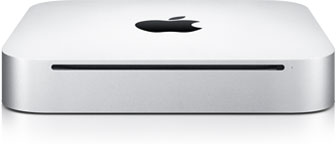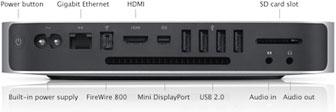For the first time since Apple introduced the original G4 Mac mini in January 2005, the company has completely redesigned the smallest, least expensive Mac.

The slimmer, wider 2010 Mac mini.
The 2010 Mac mini is shorter at 1.4″ tall – 30% thinner than earlier ones – but it’s also wider at 7.7″ (vs. 6.5″ before). It weighs a tiny bit more, but there’s a reason for the bigger footprint and extra weight: The new Mac mini design finally includes a built-in power supply. No more external power brick!
In terms of specs, it uses the same CPU found in the previous generation, but this time running it at 2.4 GHz (with a 2.66 GHz build-to-order option). That’s an inconsequential 6% speed boost at the entry level and 5% at the top end. Nice, but probably not enough of an improvement that you’ll notice it.
The 2010 Mac mini ships with 2 GB of RAM and can be easily upgraded to 8 GB; the official maximum for the previous model was 4 GB, although it will work with 8 GB. And “easily upgraded” is new to the Mac mini – just remove the bottom cover for access to the memory modules. According to Macworld, it’s also easy to swap out the hard drive.
Other than the new unibody design, the biggest change is in graphics. The new Mac mini uses the same Nvidia GeForce 320M GPU found in the current MacBook and 13″ MacBook Pro. Apple claims it is up to twice as powerful as the GeForce 9400M used in the previous Mac mini incarnation.

The back of the 2010 Mac mini.
There are some changes on the back. Apple has added an SD Card slot, making it easier to read those SD, SD-HC, mini SD, and micro SD cards without the expense and clutter of a card reader, although you do have to have ready access to the back of the computer. The Mini DVI port on recent models has given way to the widely popular HDMI connector found on most high-def TVs these days (Apple also includes an HDMI-to-DVI adapter).
The mini still supports FireWire 800, which is backward compatible with FireWire 400, gigabit ethernet, and two displays. The number of USB 2.0 ports has dropped from five to four, but most users should find that sufficient, and the built-in SD Card reader means most won’t need to plug in a USB card reader.
Finally, the new model is 25% more energy efficient than the old one, which was already the most energy efficient desktop on the market.
The Value Equation
Compared with the just-discontinued Late 2009 Mac mini, the 2010 edition has just two drawbacks – a $100 higher price point and the inability to run Mac OS X 10.5 Leopard. Considering the problems some longtime Mac users have had with OS X 10.6 Snow Leopard (at least through version 10.6.3), this could be an opportune time to snatch up last year’s model.
Steve Jobs unveiled the Mac mini in January 2005 as the least expensive Mac ever at a $499 base price. When Apple moved to Intel CPUs in 2006, the entry-level Mac mini sold for $599. And now, with its new unibody redesign, Apple has tacked another $100 on the price of the entry-level model, bringing it to $699.
Add $150 for the 2.66 GHz build-to-order option, and you get 11% more processing power at a 21% premium. We don’t see too many Mac mini buyers paying the long dollar for a bit more power, but if you do billable work that taxes the CPU (such as working with video), it could mean more productivity and profits.
The Mac mini is a lot of computer, and the 2010 version is arguably the best yet, but in an industry where prices inch downward, we’re mystified by the price increase. The bigger hard drive justifies some of it, but not nearly $100.
On the plus side for resellers, there won’t be any need to discount the close-out models if they have any remaining inventory. A bigger hard drive, a 6% faster CPU, and better graphics won’t be worth a 15% difference in price to value conscious consumers.
If you’re a gamer, the GeForce 320M graphics might be enough reason to choose the new model, and having a built-in HDMI port is a plus when connecting it to your HD TV. There’s also the convenience of a built-in SD Card reader and an internal power supply, which make it a great choice as a home theatre computer.
The online dealers I checked with either have no inventory of the 2009 Mac mini or are still selling the few remaining machines at full price. Bang for the buck, even at its full $599 price, the Late 2009 Mac mini is a better value than the new model.
Apple sometimes has refurbs available, and when it does, it’s been selling the Late 2009 model for $499 – a hot deal if ever there was one.
If I were buying a Mac mini today, the fact that the Early 2009 and Late 2009 models will run OS X 10.5 Leopard would be reason enough to choose it. I’ve read too many stories about problems with OS X 10.6 Snow Leopard to want to make that leap at present, although the just-released 10.6.4 update may resolve a lot of those issues.
Regardless, the new Mac mini is an excellent value, especially for those who won’t be migrating over years and years of collected apps, utilities, and system additions that have moved from Mac to Mac to Mac in all that time. Although Apple has boosted the price, it is still the most affordable Mac and could be an excellent replacement for that aging G4 or G5 Power Mac.
I just think that last year’s model is an even better buy.
Keywords: #valueequation #2010macmini #mid2010macmini
Short link: http://goo.gl/ynxVr5

